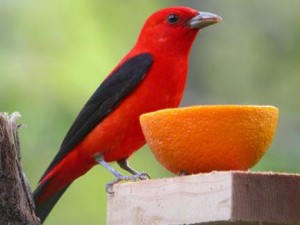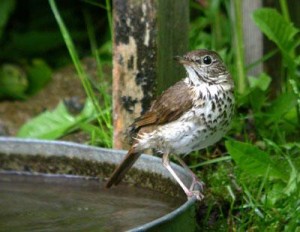Witness to Evolution
- Share
- Tweet
- Pin
- Share
Roy Lukes has been the peninsula’s most detailed and experienced chronicler of birds and the natural environment for over four decades. For our annual Sustainability Issue, we asked him to reflect on the changes he’s witnessed in nearly half a century of observing Door County’s evolution – both natural and human-imposed.
I began working as the summer naturalist at the Ridges Sanctuary in 1964, and it proved to be a fascinating beginning to nearly a half century of careful bird observing and record-keeping. That first summer a pair of Wood Thrushes nested on an overhanging branch about six feet above visitors’ heads along Wintergreen Trail. After-supper bike rides along nearby County Highway Q revealed at least a dozen pairs of these awesome singers nesting within a four-mile stretch of the road. Gradually their numbers decreased until by 1990 it was very uncommon to hear or see a Wood Thrush within the entire northern third of the county.

A male Scarlet Tanager eating orange pulp on a feeder. Both the Scarlet Tanager and Hermit Thrush appear to be maintaining population, but many other species are struggling with changing and reduced habitat.
Joining the Wood Thrush in its drastic decline in population at the Ridges are the White-throated Sparrow, Northern Waterthrush, Winter Wren, Rufous-sided Towhee, American Bittern, Green Heron, Parula Warbler, and Ovenbird, among others. Nation-wide, approximately a third of the bird species are endangered, threatened, or in serious decline, a direct result mainly of development, global climate change, air and water pollution, and loss of habitat.
We have kept careful records for 27 years of those species of birds nesting on our property or in adjacent areas. Several, including the Hermit Thrush, Scarlet Tanager, Red-bellied Woodpecker, Indigo Bunting, American Robin, Ovenbird, Rose-breasted Grosbeak, and Baltimore Oriole, appear to be holding their own very well from year to year. The total area of contiguous woods, including our own, numbers at least 100 acres. The Scarlet Tanager and Ovenbird require extensive acreage of wooded areas for nesting and are especially sensitive to checkerboard-development of wooded tracts. As a result, they move elsewhere to nest if they can find suitable areas. Often they fail to nest, further causing their numbers to fall.
One undesirable result of this type of fractured-woods development is the great increase of so-called “edge” that results. This in turn attracts edge-loving creatures including Blue Jays, Opossums, Raccoons, Brown-headed Cowbirds, Red-winged Blackbirds and Skunks. All of these animals greatly increase the hazards of nesting birds in that they frequently prey upon the adult birds, their eggs, or their young. We were dismayed a few summers ago to watch an adult Ovenbird feeding a baby Cowbird in our front yard that it had parented, at the expense of its own fledglings. Female Cowbirds parasitize the nests of dozens of our native species of birds, naturally causing the numbers of those species to decline annually. Unfortunately the Cowbirds, as a migratory species, are protected by law, as are their eggs!
Fishers were unknown when I came to the county in 1964 but since then their population has appeared to grow steadily. Their primary prey, the Porcupine, has been declining. Another unknown species north of Sturgeon Bay in 1964 was the Opossum. Their numbers too have risen to the point that they now are quite common. The Opossum numbers, along with, for example, the Turkey Vulture, Red-bellied Woodpecker, Wild Turkey and American Crow very likely are a result of the apparent northward movement among a majority of bird and animal species, not just a few, but involving entire populations. Bear in mind that we are not merely observers of these striking shifts, we are the causes of them and, yes, it should be our responsibility to do all in our power to check them, to slow them down.

An Ovenbird near the bath. Ovenbird numbers in Door County have declined drastically in the last half century.
One of the serious problems related to this widespread northern movement of birds is that many of them are arriving in Door County, during their migration, well before their insect or plant food supplies have emerged. This can be devastating to many of the birds, often resulting in deteriorating health or starvation.
An interesting reversal in this concept involves the Common Raven. In my first winter hikes at the Toft Point State Natural Area near Baileys Harbor 45 years ago, it was only then that I would hear Ravens, which had flown south to winter where food-finding was better. Come spring they would head back north to their normal nesting areas. Today Ravens have become common nesters and permanent residents throughout much of Door County. These fascinating and strong predators are known to affect the nesting success of some of our water birds, as well as smaller songbirds to perhaps a fairly small degree. The Ravens are primarily scavengers.
Exactly what factors have caused the southward movement of the Ravens may be difficult to ascertain, but surely logging, wildfires, diseases and exotic forest pests including plants, animals and insects, may all play a part.
Along with the increase in the Raven population in our county goes the Americana Crow. Thirty or more years ago it was fairly uncommon to see crows in Door County in winter. Today they number very high on our annual Christmas Bird Counts. Mechanical crop harvesting, especially of corn, leaves a considerable amount of food in the fields for the crows. Many people in suburban and country settings have planted huge numbers of conifer trees. These in turn prove to be ideal nesting sites for crows, especially when located in park-like settings including golf courses.
That people are directly the causes of shifts or declines in numbers of birds means that, rightfully and ethically, we should be helping to assess the health of bird populations and drawing general conclusions about the environment. Hopefully this will result in taking proper actions to help the birds, very valuable creatures contributing greatly to the overall health of the environment. One can easily cite three examples of birds – the Sandhill Crane, Peregrine Falcon and Eastern Bluebird – which have been helped considerably by people-developed programs.
Many other species desperately need our help. Please dedicate a part of your life to lend a hand!


